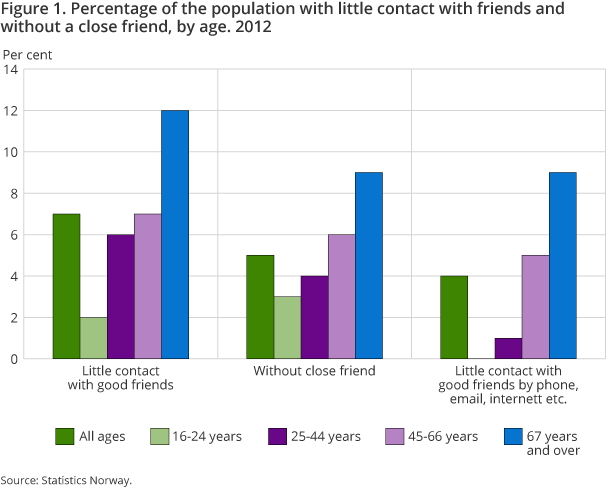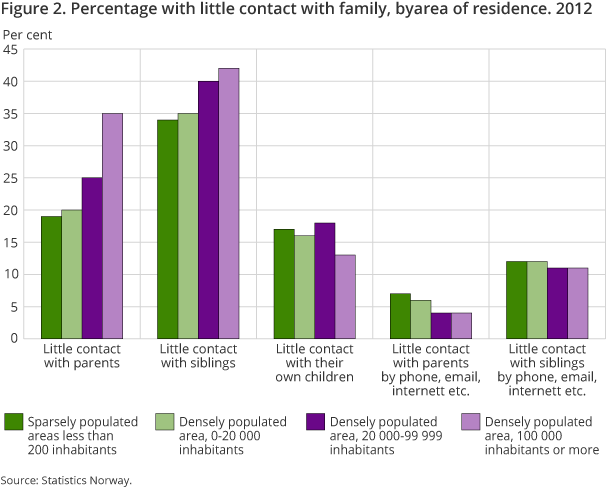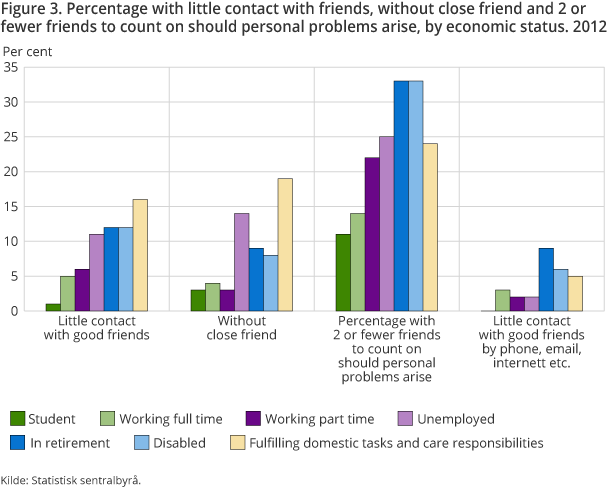Content
Published:
This is an archived release.
Few lack contact with family
Most Norwegians have a close friend and someone they can talk to about personal problems, only 5 per cent report that they do not have anybody to confide in. Very few people in the population have little contact with their family. 5 per cent have little contact with their parents and 12 per cent have little contact with siblings, including contact by telephone, email and such like.
| 2012 | ||||
|---|---|---|---|---|
| 16-24 years | 25-44 years | 45-66 years | 67 years or older | |
| Little contact with friends | 2 | 6 | 7 | 12 |
| Lacking somone to confide in | 3 | 4 | 6 | 9 |
| Proportion with 2 or fewer friends to count on, should personal problems arise | 11 | 14 | 20 | 35 |
| Hard to get help from neighbours | 10 | 11 | 9 | 15 |
| Others show little or no interest in what you do | 2 | 3 | 3 | 7 |



The Survey of level of living on health, care and social contact in 2012 examines the extent of social contact. The results show that the vast majority have a close friend and frequent contact with friends and family. The level is stable compared to the last survey in 2008. As before, the elderly more often lack a close friend. Those who do not work or study are also more likely to lack someone to confide in.
Contact with friends declines with age
In the population as a whole, 5 per cent stated that they do not have a close friend, 7 per cent have little contact with their friends and 4 per cent have little contact with friends by telephone, e-mail, the Internet or such like.
Both not having a close friend and having little contact with good friends increase with age. Nine per cent of the population over age 67 do not have someone close to them who they can confide in. In comparison, 3 per cent in the age group 16-24 years experience the same. We find the same pattern for face-to-face contact with friends and staying in touch by phone, e-mail, and the Internet. Very few young people (16-24 years) report that they have little contact with their friends. Only 2 per cent of respondents have little contact with good friends and none report having contact with their friends by phone, e-mail or the Internet less often than once a month. In comparison, 12 per cent of those aged 67 years and over have little contact with their friends, and 9 per cent have little contact with friends by phone, e-mail and such like.
Persons not in the labour market or studying have less contact with friends
Students and persons active in the labour market have more social contact than others. Three per cent of students report that they lack a close friend, and the share among employed persons is at the same level. The corresponding shares for persons outside the labour market are higher. A total of 14 per cent of unemployed persons lack a close friend, and this also applies to 8 per cent of those who are disabled. The share is even higher among home workers and people who have not stated their economic status, but these are small groups so here the findings are more uncertain. In-keeping with the fact that many of the elderly lack a confidant, 9 per cent of old age pensioners also lack a close friend. The same tendency is also found when it comes to contact with friends - those who are outside the labour market or are not studying have somewhat less contact with friends than others.
Very few do not have any form of contact with their family
Among those whose parents are alive, 25 per cent reported little parental contact. This is a slightly higher proportion than the previous survey, with a corresponding share in 2008 of 23 per cent. New in 2012 is that we also measure other forms of contact by telephone, e-mail, the Internet and such like. Measured in this way, only 5 per cent of those with living parents have little parental contact. The same is found when it comes to contact with siblings. Overall, 37 per cent reported little contact with siblings, but when we take into account the contact by telephone, e-mail, the Internet or similar, the proportion dropped to 12 per cent.
How often a person has face-to-face contact with their family varies according to where they live. Among people living in urban areas with 100 000 inhabitants or more, 35 per cent report that they have little contact with their parents and 42 per cent said they had little contact with siblings. In comparison, 19 per cent have little parental contact and 34 per cent have little sibling contact in rural areas. With regard to contact by phone, e-mail, etc. we do not find the same differences between where a person lives. There is actually a lower percentage living in urban areas that have little contact with parents by phone, e-mail, etc., than there is among people living in rural areas, with 4 and 7 per cent respectively. This is also the case for sibling contact. One explanation for this may be that there are more people who are living in cities that do not live near their family and therefore are unable to meet the family in person, but that they still have contact as often but it is by telephone, e-mail and the Internet.
Know and visit neighbours more often in rural areas
The proportion who find it difficult to get help from neighbours when they need it has remained stable over the last ten years. In 2012, 11 per cent responded that it is difficult to get help from neighbours. This means that almost nine out of ten can get help from neighbours when needed, yet there are 30 per cent who say they do not know anyone in the neighbourhood so well that they visit each other occasionally. The threshold for asking for help is therefore lower than the threshold for going to visit. Neighbour contact also varies in connection to where a person lives. In rural areas, 19 per cent do not visit neighbours, while the corresponding proportion in urban areas is 40 per cent. We find the same pattern when it comes to getting help from neighbours - a higher proportion report that it is difficult to get help from neighbours in urban areas than those living in rural areas.
The elderly and single people have fewer people to confide in
Having someone to confide in in the event of personal problems and experiencing that others care about what you do is important for many people and can give an indication of the degree of social support and networks. Most people have more than 2 people they can count on if they are experiencing personal problems, but 19 per cent of the population report having fewer. However, there are quite large variations depending on which family phase you are in. Single and elderly people experience to a much lesser extent that they have people around them that they can confide in about personal issues. Conversely, we see that younger people and those in couples experience this to a larger extent. For most people it is important that people show interest in what they do. Only 3 per cent of the population as a whole feels that others show little or no interest in what they do. Also here we see that the percentage is higher among single people and increases with age.
Sample and response rateOpen and readClose
Data from The Survey of level of living on health, care and social contact is representative for the population aged 16 years and older living in private households. A sample of 5 660 persons was interviewed by telephone. The response rate in 2012 was 58 per cent.
Contact
-
Håvard Bergesen Dalen
E-mail: havard.dalen@ssb.no
tel.: (+47) 40 90 23 50
